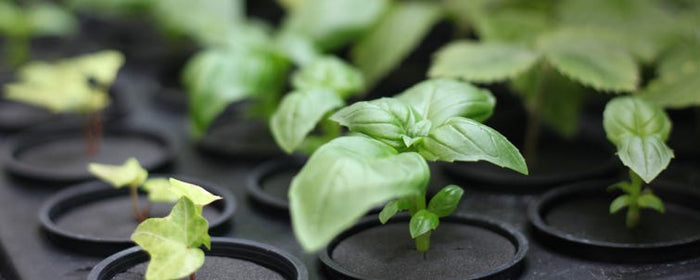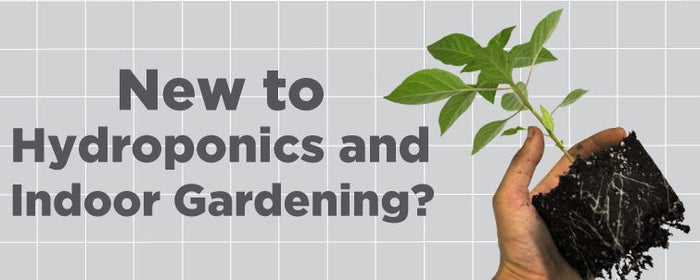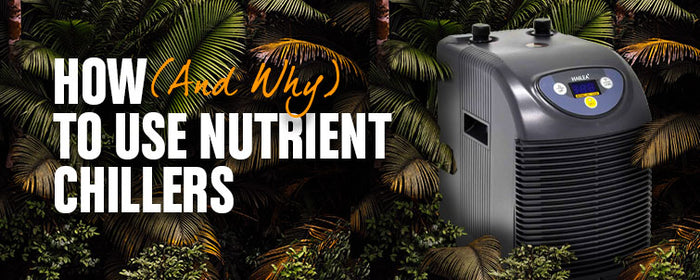
CO2 Tutorial - How to Add CO2 to a Grow Room
Plants need CO2 like we need oxygen. Fact.
CO2 + H2O + light = photosynthesis
Without carbon dioxide, plants can’t photosynthesise. In fact, if your CO2 level drops too low, plants won’t grow at all.
But how much CO2 is enough? When should you add CO2? How do you add CO2 to a grow room?
Here’s what you need to know.
Does CO2 really increase yield?
Yes.
CO2 is needed for photosynthesis, which is how plants convert light into energy.
If CO2 is restricted, so is photosynthesis (sugar production) and growth.
The thing is, there's only around 400 – 450ppm of CO2 in nature. At most, it can be as high as 800ppm in your home, just from breathing. This falls way short of the optimum 1200ppm.
Unless you add more CO2, plants won’t perform at their peak! Even a small amount of added CO2 can increase photosynthesis - and - your overall yield.

Up to 20-30% yield increase
All the other effects CO2 has on plants, along with the extra sugars makes a big difference!

Strengthen Plants
You’ll notice plants are stronger with thicker stems and branches. They'll be better able to cope with environmental extremes and pest attacks. With a thicker structure, plants will also be able to support a heavier yield.

Faster growth (shorter cycle!)
Adding CO2 speeds up growth! It's great if you want to shorten your overall cycle, or just flip to flowering sooner.

Maximise high intensity lights
When you add CO2, plants can photosynthesise more light. If you've invested in high end grow lights, adding CO2 will help you get the best out of your investment!

Help plants cope with high heats
Once absorbed, CO2 helps plants perform in temperatures up to 30oC
When should you add CO2?
You should add extra CO2 throughout your plant’s cycle. But they benefit from it most in flowering, especially at higher temperatures.
In vegetative growth
Target PPM: 600 – 700ppm
All the extra photosynthesis speeds up growth! Plants become bigger, greener and stronger in less time. This also means you can start flowering sooner when you add CO2 to your grow room.
Remember to flip to flowering when plants are just under half the size you want them to be at harvest.
In flowering
Target PPM: 1000 – 1200ppm
During bloom, you’ll slash the time it takes to produce fruit and flowers.
It’s most important to add CO2 in the first 2 – 3 weeks of bloom, when flower production starts.
During flowering, the extra CO2 can help maximise high intensity lights. Remember – for photosynthesis plants need light + water + CO2. If they have the light and water and you give them the CO2, photosynthesis will occur at a higher rate.
At What time should I add CO2?
Avoid dispensing at night. At this time plants aren’t using CO2 – they’re releasing oxygen.
Can You add too much CO2?
Any more than 1200ppm is a waste of CO2 if nothing else! You’d have to go very high, but too much CO2 can also create a toxic environment.
For this reason, it’s key that you manage your CO2 dosing properly. If using propane or bottled CO2, make sure you use a CO2 controller. If you’re using CO2 bags, just make sure you don’t hang too many of them.
How Do I add CO2 in my Grow Room?
Even a small increase in CO2 can be beneficial.
There are three ways of doing it, depending on:
- how much CO2 you want to add
- what your budget is
- how big your grow room is
1. Slow-release CO2
This is by far the easiest and lowest cost method.
You simply hang slow-release CO2 bags or bottles in your grow room. Carbon dioxide is slowly released over time.
The bags we sell are Exhale CO2 Bags & TNB The Enhancer Bottles, which are self-activated. This means they don't start releasing gas until they're in your grow room - there's no CO2 waste!
Coverage:
- Up to 3.65m x 3.65m (TNB The Enhancer)
- 1 bag per 4 - 6 plants (ExHale Bags)
Equipment needed:
- Slow-release CO2 bags or TNB bottles
- Rope Ratchets (for hanging)
Best For:
- Smaller rooms where air is extracted.
Tips:
- Hang bags just above your canopy so they don’t create a shadow.
| Pros |
|---|
|
| Cons |
|---|
|
2. Liquid Propane Gas (LPG)
This is where you produce CO2 by burning liquid propane gas.
How does an LPG CO2 Generator Work?
As liquid propane gas is burned, CO2 is released. Some heat and moisture are also released as a by-product. In veg, the extra humidity is great. In flowering, you may need to remove it.
Generally, you get more CO2 by burning propane than you get by using bottled CO2.
Coverage:
- Up to 30m2 (4kW AutoPilot Generator)
- Up to 90m2 (4kW Pro-Leaf LPG Generator)
- Up to 60m2 (8kW AutoPilot Generator)
- Up to 220m2 (10kW Pro-Leaf LPG Generator)
Equipment needed:
- Propane cannister (red / orange)
- LPG Generator (e.g. Pro-Leaf or AutoPilot)
- UK Propane Regulator (Low Pressure)
- CO2 controller (with inbuilt sensor / analyser)
- Pipe cutters
- Leak detection fluid
- Hose clamp / gas hose clips

Note: If your controller doesn't have a sensor/analyser, you can buy both separately (e.g. Ecotechnics Evolution CO2 Controller + Ecotechnics Evolution CO2 Analyser)
Best For:
- Rooms with air-cooled lights or closed-loop rooms.
TIPS:
- If you’ve got 8 lights or more, get a larger model than you need. This shortens burn time and keeps your temperature & humidity down.
- Keep a spare propane cannister
- You can cap off some burners to make them suitable in smaller spaces (e.g. 4kW to 2kW)
| Pros |
|---|
|
| Cons |
|---|
|
3. Bottled CO2 Gas
CO2 vapour is released when you need it.
You control this release using a CO2 controller, CO2 regulator (and CO2 sensor if one isn't built-in to your controller).
If you've got a good budget and want to move on from CO2 bags, this is a great option.
COVERAGE:
- Up to 12m2 / 2.4m x 4.8m (per bottle)
EQUIPMENT NEEDED:
- Bottles of CO2 gas (food grade – like pubs use)
- CO2 Dispersion tubing
- CO2 Regulator (with Solenoid valve)
- CO2 Controller (with inbuilt sensor/analyser)
- Power lead / cable fitted with plug
- 2-3 pin plug adaptor
Note: If your controller doesn't have a sensor/analyser, you can buy both separately (e.g. Ecotechnics Evolution CO2 Controller + Ecotechnics Evolution CO2 Analyser)
BEST FOR:
- Growers with small budgets who want to upgrade from CO2 bags

TIPS:
- Use multiple bottles (and regulators) if you’ve got 8+ lights
- Keep 3 bottles in total per regulator – 1 to use, 1 spare, 1 to refill
- Make sure the bottles have the male thread at the top (available in GroWell)
- Aim your dispersion tubing above your plant canopy OR through your DiffuseAir OR in through to the back of your air con unit. This will help spread CO2 evenly.
| Pros |
|---|
|
| Cons |
|---|
|
Top Tips For Adding CO2
Here's how to get the best bang for your buck when adding CO2.
1) Be Aware Of Extractor Fans
Extracting air? To stop your CO2 getting sucked out by fans, make sure you:
- Keep any CO2 bags or dosers well away from your extraction ducting
- Mix air as you dose
- Add enough CO2
2) Circulate Air
CO2 is heavier than air. Left alone it can fall down and pool at ground level.
To prevent this, mix your air. This’ll create an even CO2 level throughout your grow room.
Something like the Quest F9 Air Mover is great!
3) Add CO2 Gradually
Aim to gradually build up the supply of CO2 in your grow room.
4) Increase Your Feeds
Adding CO2 increases growth – make sure you’ve got the nutrients and water to support it by feeding plants more
5) If Possible, Switch Off Your Extraction System During Dosing
This gives plants the chance to absorb way more CO2 during dosing. Only turn fans off for a short time, and only if your temperature and humidity won’t rise too much.
6) Don’t Forget Propane Burners Produce Heat
When you spec up your climate control system you’ll need to account for them.




